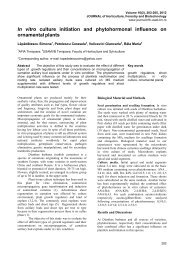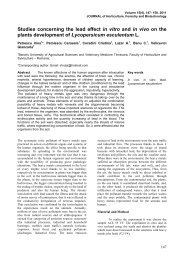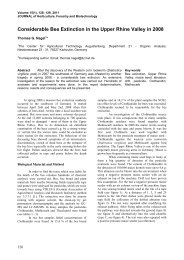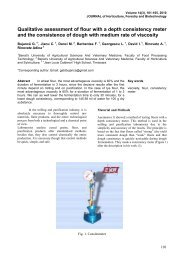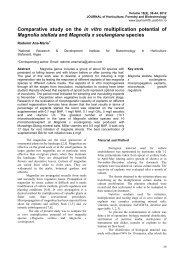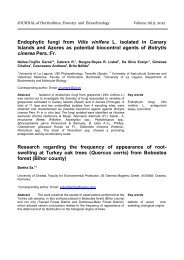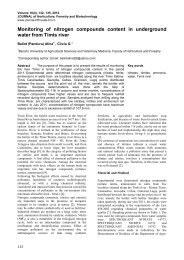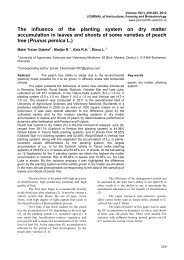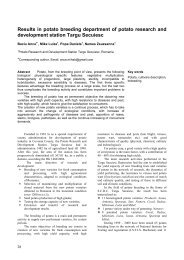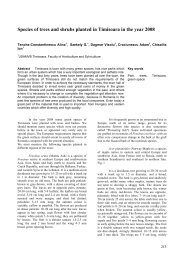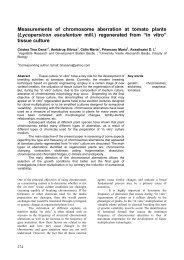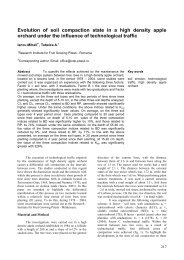Research concerning the composition and organoleptic features
Research concerning the composition and organoleptic features
Research concerning the composition and organoleptic features
You also want an ePaper? Increase the reach of your titles
YUMPU automatically turns print PDFs into web optimized ePapers that Google loves.
JOURNAL of Horticulture, Forestry <strong>and</strong> Biotechnology Volume 15(2), 2011Diversity of endophytic fungi isolated from cherry (Prunusavium)Haddadderafshi Neda 1 , Halász K. 1 , Pósa T. 1 , Péter G. 2 , Hrotkó K. 3 , Gáspár L. 1 ,Lukács N. 1*1 Corvinus University of Budapest, Faculty of Horticultural Science, Dept. of Plant Physiology <strong>and</strong> PlantBiochemistry; Budapest; 2 Corvinus University of Budapest, Faculty of Food Science, National Collection ofAgricultural <strong>and</strong> Industrial Microorganisms; Budapest; 3 Corvinus University of Budapest, Faculty ofHorticultural Science, Dept. of Floriculture <strong>and</strong> Dendrology; Budapest*Corresponding author. Email: noemi.lukacs@uni-corvinus.huAbstract Endophytic fungi are currently considered as symbionts whichcan colonize a wide range of hosts <strong>and</strong> do not induce any pathological signs.The main aim of this study was to identify <strong>the</strong> endophytic fungi colonizingdifferent organs (root, twig <strong>and</strong> leaf) of cherry (Prunus avium). Samples werecollected from eight-year-old trees of <strong>the</strong> Hungarian cultivar „Péter‟ grafted on11 different rootstocks. After surface sterilization samples were put on potatodextrose agar <strong>and</strong> outgrowing fungal colonies were visually classified after 1<strong>and</strong> 2 weeks. Then monosporation <strong>and</strong> monohyphation technique wasapplied to generate single colonies of each individual fungus, <strong>and</strong> <strong>the</strong> isolatedcolonies were classified morphologically. Molecular identification at genus orspecies level was performed by applying <strong>the</strong> polymerase chain reaction(PCR) to amplify a nuclear ribosomal internal transcribed spacer region (ITS)<strong>and</strong> by sequence comparison of <strong>the</strong> PCR products. A total of 150 endophytestrains were isolated from 4500 tissue segments. About 25 species wereidentified as belonging to <strong>the</strong> genera Acremonium, Alternaria, Botryotinia,Aspergillus, Chaetomium, Cladosporium, Embellisia, Epicoccum, Fusarium,Glomerella, Macrophomina, Neonectria, Phoma, Diapor<strong>the</strong>/Phomopsis,Pyronema, Rhizoctonia, Rhizopycnis, Rosellinia <strong>and</strong> Xylaria. Endomycotashowed <strong>the</strong> highest diversity in roots, while in twigs <strong>and</strong> leaves wepredominantly found Alternaria. Fur<strong>the</strong>r analyses are being carried out toverify which endophytes can be used to improve <strong>the</strong> physiological functions<strong>and</strong> tolerance threshold of <strong>the</strong> grafted trees against environmental stresses.Key wordsDiversity, endophytic fungi,symbiosis, Prunus avium<strong>Research</strong> <strong>concerning</strong> <strong>the</strong> <strong>composition</strong> <strong>and</strong> <strong>organoleptic</strong><strong>features</strong> of some wines from Buziaş-Silagiu (Timiş county,Romania)Ghiţă Alina 1* , Dobrei A. 1 , Mălăescu Mihaela 1 , Poiană Mariana 2 , Drăgunescu Anca 11 USAMVB Timisoara, Faculty of Horticulture <strong>and</strong> Sylviculture; 2 USAMVB Timisoara, Faculty of Technology ofFood Products*Coresponding author. Email: ghitaalina@yahoo.comAbstract <strong>Research</strong> was carried out in 2009 <strong>and</strong> 2010 on some winesfrom some red <strong>and</strong> white grape cultivars from a private vineyard located on<strong>the</strong> Silagiului Hills. The grape cultivars we studied were Mustoasă deMăderat, Fetească regală, Riesling italian, Sauvignon, Pinot gris, MuscatKey words<strong>organoleptic</strong> <strong>features</strong>,quality, white <strong>and</strong> red wines
Ottonel, Pinot noir, <strong>and</strong> Cabernet Sauvignon.The quality of <strong>the</strong> wines depends first on <strong>the</strong> quality of <strong>the</strong> rawmaterial <strong>and</strong> <strong>the</strong>n on <strong>the</strong> preparation <strong>and</strong> conditioning technology. Toestablished correlations between production <strong>and</strong> wine quality <strong>and</strong> with climateconditions, we made measurements <strong>concerning</strong> <strong>the</strong> grapes‟ degree of health,sugar content, <strong>and</strong> acidity upon harvesting. We also measured <strong>the</strong> maincomponents of <strong>the</strong> wines <strong>and</strong> <strong>the</strong>ir <strong>organoleptic</strong> <strong>features</strong>. Measuring alcoholcontent allowed <strong>the</strong> ranging of <strong>the</strong> studied wines in a certain category:superior or current consumption.As a result of our research on wine <strong>composition</strong> <strong>and</strong> <strong>organoleptic</strong> <strong>features</strong>, werecommend <strong>the</strong> use of some red <strong>and</strong> white grape cultivars with superior yieldsin <strong>the</strong> conditions of <strong>the</strong> studied area.<strong>Research</strong> <strong>concerning</strong> <strong>the</strong> impact of sulphurous anhydride ondemisec <strong>and</strong> demisweet wine maturationGhiţă Alina 1* , Dobrei A. 1 , Iordănescu Olimpia 1 , Mălăescu Mihaela 1 , Drăgunescu Anca 1 ,Cristea T. 11 USAMVB Timisoara, Faculty of Horticulture <strong>and</strong> Sylviculture*Coresponding author. Email: ghitaalina@yahoo.comAbstract We have made observations <strong>and</strong> measurements in a privatewinery from Buziaş (Timis County) on <strong>the</strong> wines from <strong>the</strong> grape cultivarsFetească albă, Sauvignon, <strong>and</strong> Pinot gris aiming at identifying <strong>the</strong> optimaldosage of sulphurous anhydride that ensures <strong>the</strong> reducing evolution duringmaturation in <strong>the</strong> barrel of demisec <strong>and</strong> demisweet wines.The condition for a wine to become valuable, with particular<strong>organoleptic</strong> <strong>features</strong>, is to go through several stages: formation, maturation,<strong>and</strong> ageing; during maturation <strong>and</strong> ageing, <strong>the</strong>re are a lot of changes that give<strong>the</strong> wine <strong>the</strong> <strong>features</strong> <strong>and</strong> qualities specific to <strong>the</strong> grape cultivar.Since preserving primary aroma, colour, <strong>and</strong> fructuosity is <strong>the</strong> mainelement of reducing wines, it is compulsory to maintain oxidation as low aspossible in <strong>the</strong> maturation recipients: in this process, using sulphurousanhydride is important. It also contributes to <strong>the</strong> formation of <strong>the</strong> bouquet in<strong>the</strong> bottle <strong>and</strong> of <strong>the</strong> sulphitic bouquet.<strong>Research</strong> focused on several moments of wine technology ofreducing demise <strong>and</strong> demisweet wines meant to improve as much as possible<strong>the</strong> quality <strong>features</strong> of <strong>the</strong>se types of wine.<strong>Research</strong> results showed that using higher rates of sulphurous anhydride ininitial sulphitation we eliminate <strong>the</strong> necessity of sulphitation during barrelmaturation <strong>and</strong> maintaining a constant ratio between total <strong>and</strong> free SO 2 ispossible only through re-sulphitation.Key wordswine maturation, winesulphitation, demisec <strong>and</strong>demisweet winesThe behavior of some new chrysan<strong>the</strong>mum cultivars(Chrysan<strong>the</strong>mum indicum L.) cultivated in pots, in greenhouseconditionsBăla Maria 1 *, Berecici D.N. 11 University of Agricultural Sciences <strong>and</strong> Veterinary Medicine Timişoara, Faculty of Horticulture <strong>and</strong> Forestry*Corresponding author. Email: mariabalamonicabala@yahoo.com
Abstract Being one of <strong>the</strong> most important species cultivated for autumndecoration, chrysan<strong>the</strong>mums are grown for cut flowers, gardens decoration<strong>and</strong> as pot plants. They can be grown by applying different technologies,depending of <strong>the</strong> cultivar, season, purpose <strong>and</strong> many more. Recently, as <strong>the</strong>needs of <strong>the</strong> market for chrysan<strong>the</strong>mums cultivated in pots has increased, weconsidered necessary to do <strong>the</strong> present research in order to observe <strong>the</strong>behavior of some cultivars destined for pot cultivation. The results haveshown great differences between <strong>the</strong>m regarding <strong>the</strong> phenology aspects,plant height, sprouting capacity <strong>and</strong> diameter of <strong>the</strong> flowers. It remains to <strong>the</strong>future to promote <strong>the</strong> cultivation of chrysan<strong>the</strong>mums as pot plants more oftenas <strong>the</strong> market needs are increasing <strong>and</strong> <strong>the</strong> number of cultivars created forthis purpose grows continuously.Keywords:chrysan<strong>the</strong>mum, pots,technology, phenologyThe influence of <strong>the</strong> planting material quality on <strong>the</strong> quantity<strong>and</strong> quality of <strong>the</strong> flowers of Freesia hybridaBerecici D.N.* 1 , Băla Maria 11 University of Agricultural Sciences <strong>and</strong> Veterinary Medicine Timişoara, Faculty of Horticulture <strong>and</strong> Forestry*Corresponding author. Email: dan84i@yahoo.comAbstract Freesia hybrida is one of <strong>the</strong> most important species cultivatedfor cut flowers. One of <strong>the</strong> biggest problems in cultivating Freesia is <strong>the</strong>degeneration of <strong>the</strong> planting material in few years so that <strong>the</strong> bulbs have to berenewed. The degeneration of <strong>the</strong> bulbs has many causes of which <strong>the</strong>essential ones are <strong>the</strong> presence of <strong>the</strong> viruses in <strong>the</strong> culture as well asFusarium <strong>and</strong> unfollowing <strong>the</strong> cultivation needs of <strong>the</strong> cultivars used. In <strong>the</strong>present paper <strong>the</strong> aim was to determine if <strong>the</strong>re is a strong influence of <strong>the</strong>planting material quality on <strong>the</strong> quantity <strong>and</strong> quality of <strong>the</strong> flowers of Freesiahybrida. The results have revealed that <strong>the</strong> bulbs quality influence <strong>the</strong> quantity<strong>and</strong> quality of <strong>the</strong> flowers but also <strong>the</strong> temperature does. Even though <strong>the</strong>rewere clear differences between <strong>the</strong> cultivars, we recommend taking <strong>the</strong>m allinto culture as all of <strong>the</strong>m have great qualities that might not be presented inthis paper or related to this paper subject.Key wordsFreesia, flowers, quality,quantityForestry habitats from Siriu Mountains (Romania)Neblea Monica 1* , Alexiu V. 11 University of Piteşti*Corresponding author. Email: monica_neb@yahoo.comAbstract In this paper are presented <strong>the</strong> main types of forestry habitatsthat can be found in Siriu Mountains. A number of six habitats according toNatura 2000 Network have been described: 9130 Asperulo-Fagetum beechforests, 91V0 Dacian Beech forests (Symphyto-Fagion), 9110 Luzulo-Fagetum beech forests, 9410 Acidophilous Picea forests of <strong>the</strong> montane toalpine levels (Vaccinio-Piceetea), 9180* Tilio-Acerion forests of slopes,screes <strong>and</strong> ravines, 91E0* Alluvial forests with Alnus glutinosa <strong>and</strong> Fraxinusexcelsior (Alno-Padion, Alnion incanae, Salicion albae).Key wordshabitat, forest, SiriuMountains, Romania
<strong>Research</strong> in soil drench application of insecticides to protecttomatoes <strong>and</strong> cucumbers crops in solariumHoza Gheorghiţa 1 , Buzatu Mihaela Alina 21 University of Agronomical Science <strong>and</strong> Veteritary Medicine Bucharest; 2 ICDLF Vidra*Corresponding author. Email: hozagh@yahoo.comAbstract The research was conducted in a solarium gown tomatoes, Prekvariety, cucumber, Mirabelle F1 hybrid, in <strong>the</strong> testing group from ICDLFVidra, Giurgiu County.In <strong>the</strong> cultures under study <strong>the</strong>re were drenched Nudrin Actar 200<strong>and</strong> SC 25 WG into <strong>the</strong> soil, 100 ml / plant each, after 10-15 days from <strong>the</strong>final planting in <strong>the</strong> solarium. The concentration of each solution was of0.008%. Both insecticides were aimed to reduce populations of greenhousewhite flies (Trialeurodes vaporariorum - Westw) <strong>and</strong> of cucumber green lice(Cerosipha gossypii – Glove). Their effect on plants was studied at each 3, 7,14, 21 <strong>and</strong> 28 days, throughout counting <strong>the</strong> number of pests remaining on<strong>the</strong> plants. From <strong>the</strong> obtained results, it can be shown that <strong>the</strong> two productsare highly effective on tracking <strong>and</strong> destroying <strong>the</strong> pests.Regarding <strong>the</strong> effect of <strong>the</strong>se pesticides on <strong>the</strong> greenhouse white fly, both attomato <strong>and</strong> cucumber cultures, it was observed that <strong>the</strong> maximum reductionof L1-L2 adult <strong>and</strong> larvae populations occurs after 21 days <strong>and</strong> of L3-L5larvae after 14 days. In what regards <strong>the</strong> cucumber green lice both productsshowed a swift, reducing 90% of <strong>the</strong> population after only three days.. Actarreduced <strong>the</strong> population at its maximum after 14 days, but Nudrin showed alonger period of time.Key wordstomatoes, cucumber, plantprotection<strong>Research</strong> regarding <strong>the</strong> behavior of some apple tree varietiesin high density plantations in Campia RomanaHoza D. 1* , Ion Ligia 1 , Diaconescu M. 1 , Iosif F., 11 University of Agriculture Science <strong>and</strong> Veterinary Medicine Bucharest, Faculty of Horticulture*Corresponding author: hozadorel@yahoo.comAbstract The extension of <strong>the</strong> culture area of <strong>the</strong> apple tree can representa solution for a higher capitalization of <strong>the</strong> field, where <strong>the</strong> pedo-climaticconditions are favorable. The comparative study of nine apple tree varietiesgrafted on M9, in superintensive orchard, in <strong>the</strong> climatic conditions of CampiaRomana, showed that <strong>the</strong> area is favorable for <strong>the</strong> apple. The growth of <strong>the</strong>trees was consistent with <strong>the</strong> biological characteristics <strong>and</strong> was slightlyinfluenced by <strong>the</strong> climatic year. The analyzed varieties showed had a goodbehavior, from <strong>the</strong> fourth year of culture <strong>the</strong> production was good <strong>and</strong> verygood, reaching values of 25 t/ha. The average of three years of study showeda high fructification capacity (29-30 t/ha) for <strong>the</strong> varieties Florina, Idared, Sirprise <strong>and</strong> Generos.Key wordsapple, superintensiveplantation, production
Studies regarding <strong>the</strong> morphological variability of some orchidspecies from Anina MountainsBîtea Nicoleta - Daniela¹*, Madoşa, E ¹, Ciulcă, S. ¹, Popescu Sorina¹, Lazăr A. ¹, Avădanei,C.¹, Velicevici, Giancarla¹¹ Banat‟s University of Agriculture Sciences <strong>and</strong> Veterinary Medicine Timisoara, Faculty of Horticulture <strong>and</strong>Sylviculture* Corresponding author: Email: nicobitea@yahoo.comAbstract The Anina Mountains is one of <strong>the</strong> areas where field literatureindicates a whole variety of orchid species. Studies have focused on <strong>the</strong>general morphological <strong>features</strong> variability <strong>and</strong> morphological <strong>features</strong> offlower variability in species Epipactis helleborine (L.) Crantz, Orchis mascula(L.) L.<strong>and</strong> Cephalan<strong>the</strong>ra damasonium (Mill.) Druce. These species havebeen identified in <strong>the</strong> forest where <strong>the</strong> dominant species were Fagus sylvaticaL. Variability of <strong>features</strong> was assessed by biometric measurements madeduring <strong>the</strong> flowering season of species. For each feature was calculated <strong>the</strong>average, <strong>the</strong> deviation from <strong>the</strong> average <strong>and</strong> coefficient of variation. Speciesanalyzed have decorative potential for both flower <strong>and</strong> leaves.Key wordsorchids, Anina Mountains,morphological <strong>features</strong>,variabilitySome aspects of surveying <strong>the</strong> park from Săvârşin, AradCountyBăbucă N. I. 1* , Ciolac Valeria 2 , Nistor Eleonora 2 , Ciolac L. 3 , Colţan O. 21 S.C. Blacklight S.R.L., Virtutii, no. 1, Timişoara, Romania; 2 Banat University of Agriculture Sciences <strong>and</strong>Veterinary Medicine, Timişoara; 3 No. 30 School, Timişoara*Corresponding author. Email: cristian.babuca@blacklight.roAbstract Topographic measurements were aimed to surveying <strong>the</strong>contours of buildings located on <strong>the</strong> property of Her Majesty, King Michael.Alleys, trees <strong>and</strong> outdoor facilities also have been subject to surveying. On <strong>the</strong>basis of <strong>the</strong> absolute rectagulare coordinates of those 62 points determined,was drawn <strong>the</strong> situation to 1:2000 scale plan that will serve for <strong>the</strong> beneficiary‟ssubsequent works of facilities.Key wordssurvey, coordinates, scale
Using 3D scan architectureBăbucă N.I. 1* , Ciolac Valeria 2 , Toma C.D. 1 , Nistor Eleonora 2 , Colţan O. 21 S.C. Blacklight S.R.L., Virtutii, no. 1, Timisoara, Romania; Banat University of Agriculture Sciences <strong>and</strong>Veterinary Medicine, Calea Aradului 119, Timisoara 300645, Romania*Corresponding author. Email: cristian.babuca@blacklight.roAbstract Recent developments in differential GPS (DGPS) serviceshave concentrated mainly on <strong>the</strong> reduction of <strong>the</strong> number of permanentreference stations required to cover a certain area <strong>and</strong> <strong>the</strong> extension of <strong>the</strong>possible ranges between reference <strong>and</strong> rover stations. Surveying with GPShas become popular due to <strong>the</strong> advantages of accuracy, speed, versatility<strong>and</strong> economy. The techniques employed are completely different however,from those of classical surveying. Provided that certain basic rules arefollowed GPS surveying is relatively straight forward <strong>and</strong> will produce goodresults. From a practical point of view it is probably more important tounderst<strong>and</strong> <strong>the</strong> basic rules for planning, observing <strong>and</strong> computing GPSsurveys ra<strong>the</strong>r than to have a detailed <strong>the</strong>oretical knowledge of <strong>the</strong> GlobalPositioning System. A GPS receiver measures <strong>the</strong> incoming phase of <strong>the</strong>satellite signals to millimeter precision. However, as <strong>the</strong> satellite signalspropagate through space to earth <strong>the</strong>y pass through <strong>and</strong> are affected by <strong>the</strong>atmosphere. The atmosphere consists of <strong>the</strong> ionosphere <strong>and</strong> <strong>the</strong> troposphere.Disturbances in <strong>the</strong> atmosphere cause degradation in <strong>the</strong> accuracy ofobservations. Starting from networked DGPS stations where all stations arelinked to a central control station for data correction <strong>and</strong> modeling, <strong>the</strong> mostadvanced technique nowadays is based on <strong>the</strong> virtual reference station (VRS)network concept. In this case, observation data for a non-existing “virtual”station are generated at <strong>the</strong> control center <strong>and</strong> transmitted to <strong>the</strong> rover. Thisleads to a significant improvement in positioning accuracy over longerdistances compared to conventional DGPS networks.Key words3D scanning, scanner,modeling, church<strong>Research</strong>es <strong>concerning</strong> <strong>the</strong> report of foliar surface-quantityqualityof some red wine vine varieties cultivated in differentecosystemsMălăescu Mihaela 1* ,Drăgunescu Aneta Anca 1 , Dobrei A. 1 , Ghiţă Alina 11 U.S.A.M.V.B.Timişoara, Faculty of Horticulture <strong>and</strong> Silviculture*Corresponding author. Email: malaescuioanamihaela@yahoo.comAbstract The goals of this research aimed <strong>the</strong> behaviour of some redwine vines: Cadarcă, Pinot noir, Merlot, Burgund, Cabernet Sauvignon indifferent ecosystems (Minis vinery, Recas vinery <strong>and</strong> <strong>the</strong> Didactic StationTimisoara) in order to establish <strong>the</strong> best direct correlations between <strong>the</strong>ir foliarsurface <strong>and</strong> grape production, quantitative, but also qualitative, starting from<strong>the</strong> premise that foliar surface is essential in obtaining vegetative biomass,respectively <strong>the</strong> production. A large foliar surface can be useless <strong>and</strong> caneven diminish <strong>the</strong> production.Deepening our knowledge of <strong>the</strong>se relationships allows <strong>the</strong> correct applicationof green works <strong>and</strong> operations of <strong>the</strong> rational culture technologies, coupledKey wordsred wine vines, foliarsurface, production, quality,quantity
with <strong>the</strong> biological characteristics of vine varieties <strong>and</strong> harmonized with <strong>the</strong>wine potential of climatic <strong>and</strong> technological capabilities of each vineyardholding (2).<strong>Research</strong>es on <strong>the</strong> adoption of cheap solutions to produce <strong>the</strong>own rooted vines for small family plantationsMălăescu Mihaela 1* , Dobrei A. 1 , Drăgunescu Anca 1 , Ghiţă Alina 1 , Velicevici Giancarla 11 U.S.A.M.V.B.Timişoara, Faculty of Horticulture <strong>and</strong> Silviculture*Corresponding author. Email: malaescuioanamihaela@yahoo.comAbstract Establishment of a vineyard requires significant financialresources <strong>and</strong> <strong>the</strong>refore is not available to anyone willing. Given <strong>the</strong> high costof grafted vines, we propose a simple <strong>and</strong> inexpensive alternative forobtaining <strong>the</strong> vines on own roots.In this paper, to obtain vines on <strong>the</strong>ir roots we taken to experience sixvarieties of vine: Fetească Regală, Muscat Ottonel, Moldova, Victoria, Muscatde Hamburg <strong>and</strong> Chasselas dore, that we have pursued during <strong>the</strong> forcing,rooting <strong>and</strong> in field in <strong>the</strong> first year after planting.The results obtained showed that <strong>the</strong> method is effective <strong>and</strong> can be achievedwith minimal costs, consequently, suited very well <strong>the</strong> family plantation.Key wordsvines on own roots,inexpensive technologyOn <strong>the</strong> behaviour of some table grape cultivars cultivated onfamily vineyardsDobrei A. 1* , Mălăescu Mihaela 1 , Ghiţă Alina 1 , Drăgunescu Anca 1 , Ciucur A. 11 U.S.A.M.V.B.Timişoara, Faculty of Horticulture <strong>and</strong> Silviculture*Corresponding author. Email: alin1969tmro@yahoo.comAbstract <strong>Research</strong> was carried out on two private vineyards located inPaulian (Arad County) <strong>and</strong> Buzias (Timis County). They focused on <strong>the</strong>variety of conveyers on <strong>the</strong> two vineyards, on <strong>the</strong> period grapes are supposedto be eaten fresh, as well as on <strong>the</strong> aspects <strong>concerning</strong> frost-resistance, budviability, <strong>and</strong> quantitative <strong>and</strong> qualitative production.The research areas ensure favourable conditions for <strong>the</strong> grape cultivars in <strong>the</strong>varietal conveyers meant to cover one‟s own consumption over a period ofabout 100 days in Paulian <strong>and</strong> 80 days in Buzias.Key wordstable grape cultivars,conveyers, family vineyards
The efficiency of vineyard exploitation by increasingmechanical works with <strong>the</strong> establishment <strong>and</strong> maintenance ofvine plantationDobrei A. 1* , Ghiţă Alina 1 , Mălăescu Mihaela 1 , Drăgunescu Anca 1 , Cristea T. 11 U.S.A.M.V.B.Timişoara, Faculty of Horticulture <strong>and</strong> Silviculture*Corresponding author. Email: alin1969tmro@yahoo.comAbstract <strong>Research</strong> has been conducted in several vine plantations ofvarious sizes in Buzias Silagiu <strong>and</strong> Recaş.Works have been pursued to establish new plantations <strong>and</strong> providemaintenance of bearing vineyards, carried out both by conventionaltechnologies with a high degree of manual work <strong>and</strong> modern technology aftera series of works (planting, harvesting, soil maintenance, operations in green)were made automatic.By comparing <strong>the</strong> two technologies, it has been more than obvious<strong>the</strong> advantage of modern technologies in terms of both cost <strong>and</strong> duration oflower enforcement which has allowed a better framing of works during <strong>the</strong>best execution period.Technology variants with high degree of mechanization can be adapted toplantations with different climatic conditions <strong>and</strong> largely removes <strong>the</strong>shallowness of performing work under a less skilled, less conscious or lessinvolved workforce.Key wordsmodern technology, classictechnology, vine plantationsStudies <strong>concerning</strong> winter resistance of some autumn oatcultivarsMadoşă E. 1* , Vasilescu Nora 2 , Ciulca S. 1 , Velicevici Giancarla 1 , Avadanei C. 1 , Bîtea Nicoleta 1 ,Ciulca Adriana 11 Banat‟s University of Agricultural Sciences <strong>and</strong> Veterinary Medicine, Faculty of Horticulture <strong>and</strong> Sylviculture,2 CR Buziaș*Corresponding author: Email: madosae@yahoo.comAbstract Oats is a plant that gives a very valuable production in terms ofquality, however, is grown on small areas because of sensibility to winterconditions. A collection of 73 varieties <strong>and</strong> lines of winter oats originated fromNorth America or West Europe, were studied. Behavior of evaluatedcollection material was different depending of year‟s specific conditions.Within <strong>the</strong> collection <strong>the</strong>re are stable genotypes, which lies on <strong>the</strong> sameposition compared to <strong>the</strong> control variety. For <strong>the</strong> breeding process <strong>the</strong>folowing varieties can be recommended as initial material: Norline, Blamouth,CI 1908, Emperor. The romanian variety Florina has a wick winter resistance,in years of <strong>the</strong> harshest winter, <strong>the</strong> risk of compromising culture apears.Key wordsautumn oats, winterresistance
Influence of different climatic conditions on phenotypeobservations regarding some yield elements in some barleygenotypesVelicevic Giancarla 1 *, Madosa E. 1 , Ciulca S. 1 , Ciulca Adriana 1 , Petolescu Cerasela 1 , BiteaNicoleta 1 , Cretescu Iuliana 1 , Ropciuc Sorina 21 Banat University of Agricultural Sciences <strong>and</strong> Veterinary Medicine, Faculty of Horticulture <strong>and</strong> Forestry,Calea Aradului, 119, 300645, Timisoara, Romania; 2 University Stefan cel Mare ,Street University, 13,720229 ,Suceava, Romania*Corresponding author. Email: giancarlavely2000@yahoo.comAbstract Drought considered as <strong>the</strong> combination of water stress plushigh irradiance <strong>and</strong> temperature stresses, is <strong>the</strong> main abiotic factor limitingyield. The improvement of <strong>the</strong> yields under drought conditions <strong>the</strong>refore mustcombine <strong>the</strong> high yield potential <strong>and</strong> specific factors which are able to protect<strong>the</strong> crop against reduction due to this stress conditions. The objective of thisstudy was to evaluate influence of different climatic conditions on phenotypeobservations regarding some yield elements of 25 genotypes of winterbarley. The genotype were tested in non stressed <strong>and</strong> stressed conditions.Key wordsbarley, yield elements ,drought stressEffects of osmotic stress in <strong>the</strong> germination stage of somebarley (Hordeum vulgare) genotypesVelicevici Giancarla* 1 , Sumalan R. 1 , Madosa E. 1 , Ciulca S 1 .,Ciulca Adriana 1 , Bitea Nicoleta 11 Banat University of Agricultural Sciences <strong>and</strong> Veterinary Medicine, Faculty of Horticulture <strong>and</strong> Forestry,Calea Aradului, 119, 300645, Timisoara, Romania*Corresponding author: giancarlavely2000@yahoo.comAbstract Osmotic stress caused by drought (water stress) or salinity is amajor problem facing agriculturae <strong>and</strong> <strong>the</strong> wildlife allower <strong>the</strong> world <strong>and</strong>especially in <strong>the</strong> developing countries. These environmental factor affectplants at various stages of growth <strong>and</strong> <strong>the</strong> development from germination,seedling stage, vegetative growth <strong>and</strong> productivity. In this study wereinvestigated 19 romanian <strong>and</strong> foreign genotypes of barley (Hordeumvulgare) regarding our germinative capacity in stress conditions. Theosmotic stress were induced by PEG 6000 solution with <strong>the</strong> osmoticpotential (-2.72 Bars, -4.48 Bars -7.35 Bars) using method suggested by (10)<strong>and</strong> replicated three time, at a temperature of 20 0 C.Therefore, drought induced by using physiological germinationsolutions with a different osmotic pressure levels directly influence <strong>the</strong>germination of <strong>the</strong> seeding material. From this parameters st<strong>and</strong> point <strong>the</strong>superior genotypes were: Andrei, Dina, DH 261-22.Key wordsbarley,droughtgermination.,
<strong>Research</strong> on identification <strong>and</strong> behavior of local vinecultivation areas Seliste - Prunisor, Arad CountyCiucur A. 1* , Dobrei A. 11 U.S.A.M.V.B.Timişoara, Faculty of Horticulture <strong>and</strong> Silviculture*Coresponding author. Email: alin_ciucur@yahoo.comAbstract Were carried out research in Arad County, in 2009 <strong>and</strong> 2010,which referred to <strong>the</strong> identification <strong>and</strong> analysis of local varieties <strong>and</strong> biotypesmainly vines planted in yards <strong>and</strong> gardens <strong>and</strong> Prunisor Seliste ruralpopulation.The purpose of this research was to highlight <strong>the</strong> biological <strong>and</strong>technological characteristics of grape varieties in <strong>the</strong> western part ofRomania, who, although <strong>the</strong>y have good or very good qualities, both in termsof quantity <strong>and</strong> quality of production not exp<strong>and</strong>ed <strong>the</strong>ir vineyard in practice.To characterize cultivars ampelography references were made to <strong>the</strong> mostimportant descriptors ampelography: leaf, grape <strong>and</strong> grain. To establish <strong>the</strong>name of local varieties <strong>and</strong> cultivars has appealed to many criteria (name oflocal folk if any, communities in which <strong>the</strong> initials were discovered, <strong>the</strong> initialsthat were discovered street, house number of householders, <strong>features</strong> <strong>and</strong>Technology ampelografice predominant, etc.. ).Key wordslocal varieties, biological<strong>and</strong>technologicalcharacteristicsRapid leaf Area Estimation of Crytorchid monteiroaeOlosunde, M.A 1 . <strong>and</strong> Dauda, T.O 2 .1 Department of Horticulture, Unversity of Agriculturre, Abeokuta, Nigeria; 2 Institute of Agricultural <strong>Research</strong><strong>and</strong> Training, Obafemi Awolowo University, PMB 5029, Moor Plantation, Ibadan, Nigeria*Corresponding author. Email: taofikdaud@yahoo.comAbstract Leaf area measurement of Cyrtorchis monteiroae was carriedout at <strong>the</strong> University of Agriculture, Abeokuta, Nigeria in 2008. The objectiveof this study was to assess rapid leaf area estimation from both destructive<strong>and</strong> nondestructive sampling methods for Cyrtorchis monteiroae. Leafsamples were r<strong>and</strong>omly selected from lower, middle <strong>and</strong> upper parts of <strong>the</strong>plant. Leaf length, leaf width, product of leaf length <strong>and</strong> width, leaf dry weight<strong>and</strong> leaf area from <strong>the</strong> graphical method were determined. The resultsshowed that leaf width has <strong>the</strong> minimum variance (2.083) while leaf length ×leaf width had <strong>the</strong> maximum variance (428.497). Also, all <strong>the</strong> consideredgrowth indices were directly <strong>and</strong> significantly correlated. Of <strong>the</strong> entireinvestigated model, cubic model of <strong>the</strong> relationships between leaf area <strong>and</strong><strong>the</strong> leaf length × leaf width gave <strong>the</strong> best result in term of minimum residualvariance <strong>and</strong> highest coefficient of determination.Key wordsexponential model, cubicmodel, residual variance,monopodial
Effects of some bioactive foliar products that stimulate flowerset <strong>and</strong> of some irrigation methods upon capsicum productioncultivated in different fertirrigation systemsHorgoş A. 1* , Becherescu Alex<strong>and</strong>ra 1 , Popa D. 1 , Ienciu Anişoara 1 , Drăgunescu Anca 11 Banat‟s University of Agricultural Sciences <strong>and</strong> Veterinary Medicine Timişoara*Corresponding author. Email: horgos_a@yahoo.comAbstract The cultivar as technological factor with large share inobtaining large <strong>and</strong> sustained crop due to its qualities as genetic expression,can‟t display at maximum it‟s available productive <strong>and</strong> qualitative potentialunless we don‟t apply a cultivation technology as its possibilities forexpression, both in field crops <strong>and</strong> ultimately forced or protected system (insolarium or in greenhouses heated or unheated).Technological factors such as <strong>the</strong> irrigation method applied,fertilization system or methods used to stimulate <strong>the</strong> binding of flowers, whichis lacking in this species in some phases of vegetation of this culture, etc,have a major impact on quantitative <strong>and</strong> qualitative level of production thatmay be achieved.<strong>Research</strong> has been done in comparative culture of competition ingreenhouses covered with polyethylene film, in this regard have been initiatedby <strong>the</strong> method experience of subdivided polifactorial parcels located in threerepetitions. The experiment had in mind <strong>the</strong> manifestation way of quality <strong>and</strong>productive potential of hybrid F1 Ofanto interactions under <strong>the</strong> influence ofthree technological factors (factor A - method of irrigation, factor B -fertilization system used, factor C - products applied by foliar spraying tostimulate binding to plant flowers <strong>and</strong> speeding up <strong>the</strong> metabolism).The paper highlights <strong>the</strong> influence of unilateral experimentaltechnological factors <strong>and</strong> interactions on <strong>the</strong> level of production quality <strong>and</strong>quantity of pepper is obtained <strong>and</strong> recommendation on <strong>the</strong> economicefficiency of this crop.Key wordscultivar,potential,production, species, factor,technologyLight intensity in <strong>the</strong> culture place <strong>and</strong> mycelium“reincubation”, technological factors with major impact upon<strong>the</strong> production level of Pleurotus ostreatus HK-35, P-80 <strong>and</strong> K-12 hybridsHorgoş A. 1* , Becherescu Alex<strong>and</strong>ra 1 , Popa D. 1 , Negrea C. 11 Banat‟s University of Agricultural Sciences <strong>and</strong> Veterinary Medicine Timişoara*Corresponding author. Email: horgos_a@yahoo.comAbstract The exigencies of Pleurotus ostreatus to a minimum luminousintensity to <strong>the</strong> optimum are well known <strong>and</strong> vary depending on <strong>the</strong> species(P. florida <strong>and</strong> P. cornucopiae, P. sajor-caju, P. pulmonarius etc.). Themanifestation of carpophores to <strong>the</strong> influence of light intensity fluctuations ofP. ostreatus fruit bodies (cap <strong>and</strong> stalk) as <strong>the</strong>ir shape <strong>and</strong> size or only a partof it (ei<strong>the</strong>r <strong>the</strong> cap or <strong>the</strong> stalk), is actually a departure to <strong>the</strong> formalizedquality st<strong>and</strong>ards of quality norms.Key wordsmushroom, intensity, light,technology, mycelium,incubation, production
In this paper we present <strong>the</strong> results of an experimental approach on <strong>the</strong>response of some hybrids of P. ostreatus (HK-35, P-80 <strong>and</strong> K-12) tovariations of light intensity (dark → 500 lux) in conditions of moderntechnological links application on incubating <strong>the</strong> mycelium, namely <strong>the</strong>"reincubation" applying to <strong>the</strong> Ist flush of production after harvest.Study of <strong>the</strong> impact of plant’s support <strong>and</strong> fertilisation systemsupon <strong>the</strong> productive <strong>and</strong> quality potential manifestation ofsome tomato hybrids cultivated in solariumsBecherescu Alex<strong>and</strong>ra 1* , Horgoş A. 1* , Drăgunescu Anca 1 , Ienciu Anişoara 1 , Popa D. 1 ,Bătrân Marinela 21 Banat‟s University of Agricultural Sciences <strong>and</strong> Veterinary Medicine Timişoara; 2 Family association*Corresponding author. Email: alex<strong>and</strong>ra_becherescu @yahoo.comAbstract Due to continued growth of fuel prices <strong>and</strong> heating <strong>and</strong>electricity mainly, it was impossible <strong>the</strong> vegetable cultivation in greenhousesheated by private growers. But generally, to increase <strong>the</strong> profitability invegetable crop in case of tomatoes removing <strong>the</strong> heating costs is not enough, but also improving those technology links to offset <strong>the</strong> influence of heatinglack , which led to a decrease in almost all early production, but also it‟squality during <strong>the</strong> first part of <strong>the</strong> harvest period.This paper presents results regarding <strong>the</strong> influence of <strong>the</strong> interplaybetween experimental factors, correspondents of major technological links ofproduction <strong>and</strong> its quality <strong>and</strong> hence on economic efficiency of <strong>the</strong> culture.Key wordssolarium,culture,vegetables, fertilizers,hybrid, production, tomatoThe period of founding culture <strong>and</strong> leading system invegetation, determinant technological factors of tomato cultureprofitableness in industrial greenhouses with unconventionalenergetic consumeBecherescu Alex<strong>and</strong>ra 1 *, Horgoş A. 1 , Popa D. 1 , Drăgunescu Anca 1 , Jurj R. 11 Banat‟s University of Agricultural Sciences <strong>and</strong> Veterinary Medicine Timişoara*Corresponding author. Email: alex<strong>and</strong>ra_becherescu @yahoo.comAbstract Tomato crop production provides an easy <strong>and</strong> efficient marketcapitalization, with <strong>the</strong> lowest energy consumption compared to o<strong>the</strong>rvegetable crops such as <strong>the</strong>rmophilic peppers, eggplants <strong>and</strong> cucumbers, <strong>the</strong>dominant species in greenhouse <strong>and</strong> solarium cultures. The existing situationin terms of opportunities for growers of allocating energy balance, which willnot affect <strong>the</strong> profitableness of tomato culture, required choosing anassortment of tomato hybrids to correspond to <strong>the</strong> current needs, <strong>the</strong> supplyof seed on <strong>the</strong> market of specialised firms being extremely rich.New hybrids in recent years have arisen in terms of production levelsachieved <strong>and</strong> <strong>the</strong>ir quality, but <strong>the</strong>y must be studied under various aspects.The behaviour of different densities in culture is essential given that becauseof lower energy available due to a low price/Gcal always growing, planting isKey wordscultivation,hybrid,consumption,profitablenessproduction,energysortiment,
done late, one of which was <strong>the</strong> beginning of March.Similarly important is <strong>the</strong> aspect of leading mode in growth period,hence deriving conclusions on <strong>the</strong> profitability of culture, profit is stronglyinfluenced by <strong>the</strong> costs incurred, <strong>the</strong>se varying according to culture density.[2]This paper presents <strong>the</strong> behaviour of two of <strong>the</strong> newest hybrids oftomato semidetermined growth, grown in industrial greenhouses withunconventional heating in terms of culture profitableness under <strong>the</strong> influenceof <strong>the</strong> culture period founding <strong>and</strong> vegetation leading system.Mechanical models of <strong>the</strong> mixture layer from <strong>the</strong> cleaningsystem of harvesting combinesIlea R. 1* , Tonea Cornelia 1 , Popa D. 1 , Drăgoi Gh. 11Banat‟s University of Agricultural Sciences <strong>and</strong> Veterinary Medicine, Faculty of Agriculture* Corresponding author. Email: ileaupc@yahoo.comAbstract The operation of separation of seeds is realized due to <strong>the</strong>vibration of flat sieve. The operation of separation is analyzed with <strong>the</strong> help of<strong>the</strong> layer of mixture model which executes vibration motions on a plane withfriction. This paper analyzed <strong>the</strong> following models of layer material:Fajbuševič model, Wacker model <strong>and</strong> most exact model. The paper have areal interdisciplinary character because requires large knowledge ofmechanics, agricultural machines, ma<strong>the</strong>matics <strong>and</strong> computer programming.Key wordsmixture layer, dynamicmodel, flat sieve, vibrotransport,sliding regimes<strong>Research</strong> on <strong>the</strong> relation-tillage-fuel production from maize interms of Didactic Station TimisoaraPopa D. 1* , Tonea Cornelia 1 , Ilea R 1 ., Drăgoi Gh 1 ., Becherescu Alex<strong>and</strong>ra 11 Banat‟s University of Agricultural Sciences <strong>and</strong> Veterinary Medicine Timişoara*Corresponding author. Email: popadaniel67@yahoo.comAbstract Mechanized soil tillage though classical methods becomesmore <strong>and</strong> more doubtful due to a high energy intake <strong>and</strong> to a continuous soildegradation because of <strong>the</strong> excessive setting.It is well known that <strong>the</strong> classical system of processing <strong>the</strong> soil (tillagewith an earth board plough) has, besides its extraordinary contributions tosocial progress, seriously prejudiced <strong>the</strong> environment <strong>and</strong> its vital resource –soil – leading to a steady diminution of its fertility.The disadvantages attributed to <strong>the</strong> classical soil work system, anintensive system that includes compulsory earth board plough tillage, resultedin <strong>the</strong> appearance <strong>and</strong> rapid spread of <strong>the</strong> concept of soil conservation.Romanian literature shows that in <strong>the</strong> conventional system, soil works need35-60% of <strong>the</strong> fuel necessary to set <strong>and</strong> maintain a crop. <strong>Research</strong> <strong>and</strong> <strong>the</strong>expansion of minimum tillage systems have become important since <strong>the</strong>necessity to reduce production costs <strong>and</strong> <strong>the</strong> risks of soil degradation, setting,<strong>and</strong> erosion.<strong>Research</strong> data show <strong>the</strong> fact that in order to obtain an increase ofagricultural production of 1% we need a fuel consumption of 2.5%.In this paper we present a syn<strong>the</strong>sis of <strong>the</strong> results obtainedexperimentally <strong>concerning</strong> fuel consumption in different minimum tillageKey wordstillage, direct drill, fuelconsumption, production,maize
variants compared to <strong>the</strong> classical system.Study on fungal load of pome fruits, hazardous factor forquality maintaining <strong>and</strong> ensuring <strong>the</strong> consumer safetyȘumălan Renata Maria* 1 , Doncean Ancuța 1 , Șimonea Luciana 1 , Șumălan R. 1 , Camen D 1 .,Beinsan Carmen 1USAMVB Timisoara , Faculty of Horticulture <strong>and</strong> Silviculture*Corresponding author: srenata_maria@yahoo.com; 4soilmicrobiology@gmail.comAbstract Three varieties of apples <strong>and</strong> pears from indigenous <strong>and</strong>external sources have been studied, in regards <strong>the</strong> mesophilic <strong>and</strong>psyhrophilic fungal load. Czapek medium isolation method based on <strong>the</strong>principle of dilution allowed us to determine <strong>the</strong> number of fungi after 5 daysof incubation. The biggest load of mesophilic fungi we determined for Idaredapples from Romania. After <strong>the</strong> macroscopic <strong>and</strong> microscopic examination ofisolated fungi we were identified six species of filamentous fungi Botrytiscinerea, Penicillium expansum, Aspergillus restrictus, Penicilliumchrysogenum, Penicillium solitum, <strong>and</strong> Fusarium equiseti. In <strong>the</strong> category ofstrict mesophilic fungi we have Aspergillus restrictus, Penicilium chrysogenum<strong>and</strong> Fusarium equiseti. The Penicilium expansum, Botritis cinerea <strong>and</strong>Penicillium solitum , we find in both classes of mesophilic <strong>and</strong> psyhrophilicfungi. Calculation of frequency of occurrences on <strong>the</strong> plates for each fungalspecies showed that <strong>the</strong> most bigger frequency was determined for P. solitum(100%) for <strong>the</strong> Golden apples from Romania <strong>and</strong> B. cinerea (80%) for <strong>the</strong>Cure pears from Romania. Application of postharvest measures ofconditioning <strong>and</strong> storage has results in reducing <strong>and</strong> limiting <strong>the</strong> spread offungi, <strong>the</strong>ir importance was established on <strong>the</strong> William pears from Chile.Key wordsfungi spoilage, mesophilic<strong>and</strong> psyhrophilic fungus,apples, pearsThe environmental factors <strong>and</strong> <strong>the</strong>ir influences on mainphysiological processes on apple treesGruia M. 1* , Baciu A. 1 , Cosmulescu Sina 11 University of Craiova, Faculty of Horticulture*Corresponding author. Email:gruiamarius@gmail.comAbstract The influences of environmental factors on <strong>the</strong> cultivars arevery important in <strong>the</strong> orchard. In order to obtain good quality crops it isnecessary to know <strong>the</strong> interaction between plants <strong>and</strong> environmental factors(light, temperature, CO 2 concentration in <strong>the</strong> air, soil humidity, soil fertility,etc.)This paper's aim is to study <strong>the</strong> physiologic reaction (photosyn<strong>the</strong>sis rate,transpiration rate, stomatal conductance of CO 2 ) of few apple cultivars toenvironmental factors (temperature, light). Unfavorable environmentalconditions (temperature, light, too much or too little) cause <strong>the</strong> change in <strong>the</strong>development of physiologic processes.Fuji <strong>and</strong> Pinova are <strong>the</strong> most adapted cultivars for <strong>the</strong> studied area.Key wordsapplecultivars,environmental factors,physiological processes
Soil quality in <strong>the</strong> Gurahont depressionBalaşcău D. 1* , Borza I. 11 USAMVB Timisoara, Faculty of Agriculture*Corresponding author. Email: gelu_balascau@yahoo.comAbstract Soil reaction in <strong>the</strong> Gurahont Depression is as follows: of <strong>the</strong>8,938 ha of arable l<strong>and</strong>, 1,609 (18%) are acid, 5,810 ha (65%) are less acid,536 ha (6%) have a neuter reaction <strong>and</strong> 983 ha (11%) have an alkalinereaction.In this paper, <strong>the</strong> authors present <strong>the</strong> eco-pedologic <strong>features</strong> of two types ofsoil representative for <strong>the</strong> agricultural area of <strong>the</strong> Gurahont Depression:typical luvosoil, moderate stagno-gleyed, medium clay/loamy-clayish onaltered disaggregated materials in situ very fine not carbonated <strong>and</strong> enticgleyicaluvisoil, strongly gleyed, s<strong>and</strong>y/clayish/clay-s<strong>and</strong>y, on coarse notcarbonated fluviatile materials.Key wordssoil, <strong>features</strong>, types, profile,content<strong>Research</strong>es <strong>concerning</strong> <strong>the</strong> impact of some soil maintenancesystems upon fruits’ quality of Generos apple tree varietyMicu Roxana Elena 1* , Iordănescu Olimpia 11 Banat‟s University of Agricultural Sciences <strong>and</strong> Veterinary Medicine Timişoara, Faculty of Horticulture <strong>and</strong>Forestry*Corresponding author. Email: roxanna_micu@yahoo.comAbstract Modern <strong>and</strong> durable fruit culture is based on improvedtechnologies, for this purpose aiming at rational <strong>and</strong> systematic humanintervention in <strong>the</strong> life of fruit species, during <strong>the</strong>ir entire period of growth <strong>and</strong>individual development.In trees <strong>and</strong> shrubs culture technology, <strong>the</strong> choice of soilmaintenance is an important operation because it must be done considering:<strong>the</strong> climatic conditions of <strong>the</strong> area of culture, <strong>the</strong> culture system, <strong>and</strong>biological peculiarities of <strong>the</strong> species, variety <strong>and</strong> rootstock, technicalequipment. By choosing <strong>the</strong> best system maintenance, trees will not competewith weeds for nutrients absorption <strong>and</strong> thus will get constant fruit production<strong>and</strong> quality.In this purpose, we established 10 variants of soil maintenance, inwhich we used both agrotechnical <strong>and</strong> chemical methods for controllingweeds, such as: mechanical <strong>and</strong> manual hoes on <strong>the</strong> tree rows <strong>and</strong> on <strong>the</strong>interval, manual hoes on <strong>the</strong> tree row combined with herbicides, while <strong>the</strong>interval was ei<strong>the</strong>r seeded with grass mixture, ei<strong>the</strong>r just mowed.The best results <strong>concerning</strong> apples‟ quality were obtained in variant 9, where<strong>the</strong> interval was seeded with Trifolium repens <strong>and</strong> on <strong>the</strong> tree rows we appliedherbicide Roundup 360 SL (3 l/ha).Key wordsGeneros, apples, quality,soil maintaining systems
in winter wheat.<strong>Research</strong> on <strong>the</strong> viability of buds <strong>and</strong> resistance to wintering ofsome varieties <strong>and</strong> biotypes from Buziaş-Silagiu areaMoş Victoria 1* , Dobrei Alin 11 USAMVB Timisoara, Faculty of Horticulture <strong>and</strong> Sylviculture*Corresponding author. Email: avborca@yahoo.comAbstract The climatic conditions are very important for successfulcultivation of vines in certain areas. To browse in good condition during <strong>the</strong>cold winter, it is absolutely necessary appropriate technology culture whichpromotes a proper maturation of tissues <strong>and</strong> organs of <strong>the</strong> vine. Vine frostresistance is different depending on <strong>the</strong> variety, degree of maturation oftissues, <strong>the</strong> repose phase occurs, how are installed <strong>the</strong> frost, etc. Resistanceof different organs of <strong>the</strong> vine is also different, so <strong>the</strong> buds frost resistance isinfluenced by culture technology, production levels, climatic conditions of <strong>the</strong>current year, but also <strong>the</strong> genotype. In recent years, oscillating climaticconditions have been influencing both <strong>the</strong> quality <strong>and</strong> quantity of productionas well as mode of vines wintering. In this paper we presented resistance tocold <strong>and</strong> <strong>the</strong> viability's buds of some varieties <strong>and</strong> biotypes from Buziaş-Silagiu area.Key wordsgenotype, viability, climaticconditions, Buziaş-Silagiu<strong>Research</strong> <strong>concerning</strong> <strong>the</strong> grapes quality of some local varieties<strong>and</strong> biotypes, suitable for a sustainable viticultureMoş Victoria 1* , Dobrei Alin 11 USAMVB Timisoara, Faculty of Horticulture <strong>and</strong> Sylviculture*Corresponding author. Email: avborca@yahoo.comAbstract Buziaş-Silagiu area has a long tradition in vine culture, as wineis an occupation for <strong>the</strong> inhabitants of this area since ancient times. In thisarea exists an abundance of local varieties <strong>and</strong> biotypes, which are lessknown. Some of <strong>the</strong>se varieties have valuables agrobiological <strong>and</strong>technological <strong>features</strong> both for growers <strong>and</strong> consumers, but also for breeders:high production, high quality, drought resistance, frost resistance, tolerance tosome diseases <strong>and</strong> pests. These qualities recommend <strong>the</strong>m for a sustainableviticulture.Key wordsbiotypes, local varieties,Buziaş-Silagiu, sustainableviticulture
Impact of technological parameters on yield in spring oatCârciu Gh 1 ., Lăzureanu A 1 ., Alda S 1 ., Manea D 2 ., Băluţă Daniela 1 , Ştefan Carolina 1 ,Cîrciu Lenuţa Gheorghina 1 , Cristea T 1 .1 USAMVB Timişoara, 1 Faculty of Horticulture <strong>and</strong> Silviculture, 2 Faculty of Agriculture* Corresponding author. Email: carciu_gheorghe@yahoo.comAbstract <strong>Research</strong> was carried out between 2009 <strong>and</strong> 2010 <strong>and</strong>focused on <strong>the</strong> following: impact of sowing density on yield, impact ofchemical fertiliser rates, interactions between sowing density <strong>and</strong> fertilisationlevel, impact of climate conditions on <strong>the</strong> studied factors.The trials were bi-factorial of <strong>the</strong> 3x5 type with 4 replicas. We studied 2factors: Factor A – sowing density <strong>and</strong> Factor B – fertilisation level. Yield in<strong>the</strong> two experimental years was influenced by both sowing density <strong>and</strong>fertilisation level. In 2009, oat production oscillated between 18.33 q/ha (500g.g./m 2 ) <strong>and</strong> 22.17 q/ha (400 g.g./m 2 ), while in 2010 it yielded between 21.89q/ha (500 g.g./m 2 ) <strong>and</strong> 27.00 q/ha (400 g.g./m 2 ). The highest yield was whenfertilised with N 90 P 60 K 60 , i.e. 32.32 q/ha. Analysing <strong>the</strong> interaction of <strong>the</strong> twofactors, we see that in <strong>the</strong> interaction 400 g.g./m 2 – N 120 P 60 K 60 we obtained<strong>the</strong> highest yield, i.e. 35.46 q/ha in <strong>the</strong> year 2010.Key wordsspring oat, sowing density,fertilisationlevel,production, interactionStudies regarding powdery mildew resistance (ErysipheGraminis F.Sp. Hordei) in winter barleyCiulca S. 1* , Madoşă E. 1 , Ciulca Adriana 1 , Velicevici Giancarla 1 , Chis S. 11 USAMVB Timisoara, Faculty of Horticulture <strong>and</strong> Sylviculture*Corresponding author. Email: c_i_sorin@yahoo.comAbstract Development of resistant varieties is <strong>the</strong> most economical <strong>and</strong>environmentally safe method by reducing <strong>the</strong> application of fungicides tocombat this disease. Efforts to identify new <strong>and</strong> diverse sources of resistanceare important in relation to disease resistance management, in this regard isrequire comparing a large number of new sources <strong>and</strong> st<strong>and</strong>ards. Theobjective of this study was to determine powdery mildew (Erysiphe graminisf.sp. hordei) resistance estimated by <strong>the</strong> attack intensity levels, of 23 winterbarley varieties during 2006-2008. Taking into account <strong>the</strong> fact that <strong>the</strong>rewere no significant differences in attack intensity from one year to ano<strong>the</strong>r,given <strong>the</strong> results of <strong>the</strong> entire experimental period it is noted that <strong>the</strong> bestresistance to powdery mildew, were showed by varieties: Regal, Ulla,Compact, Hauter. The highest values of <strong>the</strong> attack, intensity during <strong>the</strong>experiment, were highlighted by <strong>the</strong> varieties: Lyric, Gerbel, Riniker, Pfyner,amid considerably longer growing periods than all o<strong>the</strong>r varieties.Key wordswinter barley, powderymildew, resistance
Studies <strong>concerning</strong> <strong>the</strong> genetic analysis of grain number/spikein winter wheatCiulca S. 1 *, Madosa E. 1 , Ciulca Adriana 1 , Velicevici Giancarla 1 , Chis S. 1USAMVB Timisoara, Faculty of Horticulture <strong>and</strong> Sylviculture*Corresponding author. Email: c_i_sorin@yahoo.comAbstract Grain yield is a complex trait made up of <strong>the</strong> interactionbetween different yield components <strong>and</strong> environmental effects. Because ofthat, it is necessary to know <strong>the</strong> genetic architecture of yield components. Theaim of this study was to estimate <strong>the</strong> gene effects <strong>and</strong> heritability in six wheatcrosses between four cultivars, using generation mean analysis (P1, P2, F1,F2, B1 <strong>and</strong> B2). In all hybrid combinations high <strong>and</strong> significant values ofbigenic effects have been obtained <strong>and</strong> especially for additive x dominantinteraction. In case of combinations Flamura 85 x Romulus <strong>and</strong> Flamura 85 xGreiff, it appears that <strong>the</strong> dominance effects are significant <strong>and</strong> have <strong>the</strong>largest contributor to <strong>the</strong> genetic determinism of this trait. In contrast, <strong>the</strong>dominance has small <strong>and</strong> insignificant values in Romulus x GKGobe <strong>and</strong> arevirtually missing, in <strong>the</strong> case of combination Greiff x G.K.Gobe.To increase<strong>the</strong> possibility of favorable genes accumulation for <strong>the</strong> number of grains/spike<strong>and</strong> thus raise <strong>the</strong> selection efficiency is necessary to select <strong>and</strong> cross <strong>the</strong>best segregates from each hybrid combinations. For this goal especially <strong>the</strong>combinations: Flamura 85 x Greiff <strong>and</strong> Flamura 85 x Romulus will be used.Key wordswinter wheat, geneticanalysis,grainnumber/spikeQuality evaluation of some maize hybrids cultivated underpedoclimatic conditions of Banat area (West of Romania)Alda S. 1 , Lăzureanu A. 1 , Cârciu G. 1 , Niţă L. 2 , Alda Liana 3 , Cristea T. 1 , Danci M. 11 USAMVB Timisoara, Faculty of Horticulture <strong>and</strong> Forestry, 2 USAMVB Timisoara, Faculty of Agriculture,3 USAMVB Timisoara, Faculty of Agro-Food Processing Technologies*Corresponding author. Email: aldasimion@yahoo.comAbstract The purpose of <strong>the</strong> researche is to follow <strong>the</strong> influence of <strong>the</strong>biological factor on quality of eight maize hybrids of various maturity groupsFlorencia(FAO 500), ZP 409(FAO 500), Fundulea 376(FAO 500), Olt(FAO430), TC 377(FAO 390), Stira (FAO 390), Garbure(FAO 370) <strong>and</strong> LG3395(FAO 370). An experiment was set up on a cambic chernozem atTimisoara(west of Romania) in 2010, in a r<strong>and</strong>omised block design with fourreplications, <strong>the</strong> level of fertilization being N 130 P 60 K 60 . Quality parameters thatwere monitored to determine <strong>the</strong> quality of maize cultivars are moisture,hectoliter mass, protein, oil, <strong>and</strong> starch content. We can conclude thatinfluence of genetic background of various types has been different for yield<strong>and</strong> quality parameters. Regarding <strong>the</strong> correlations between qualityparameters of maize hybrids our researches leaded us to <strong>the</strong> conclusion thatbetween protein content <strong>and</strong> oils content <strong>the</strong>re was a positive correlation butbetween hectoliter mass <strong>and</strong> starch content <strong>the</strong> correlation was negative.Key wordsmaize hybrid, yield, protein,hectoliter mass, oil, starch
The dynamic of pigments level in sunflower sprouts after zinccompounds supplementing in growthAlda S. 1 , Moldovan Camelia 2 , Dogaru Diana 2 , Alda Liana 2 , Niţă L. 31 USAMVB Timisoara, Faculty of Horticulture <strong>and</strong> Forestry, 2 USAMVB Timisoara, Faculty of Agro-FoodProcessing Technologies, 3 USAMVB Timisoara, Faculty of Agriculture*Corresponding author Email: aldasimion@yahoo.comAbstract The purpose of this paper is to study <strong>the</strong> dynamic of pigmentslevel in sunflower sprouts after zinc compounds supplementing in growth.Was evaluated as <strong>the</strong> content of total chlorophylls, chlorophylls a, chlorophyllsb, carotenes <strong>and</strong> xanthophylls. Seedlings were obtained by germinating ofsunflowers greens in <strong>the</strong> presence of Zn. For germination were used textilegermination beds. There were six groups: Group 1 - distilled water;Group 2 -potable water; Group 3 - ZnSO 4 -50 ppm Zn;Group 4 - ZnSO 4 -100 ppmZn;Group 5 - (CH 3 COO) 2 Zn -50 ppmZn;Group 6 - (CH 3 COO) 2 Zn- 100 ppm Zn.We observed <strong>the</strong> increasing of chlorophyls a,b <strong>and</strong> total for <strong>the</strong> groups treatedwith zinc sulfat, comparative with control groups <strong>and</strong> <strong>the</strong> negative influence ofzinc acetate solution on pigments syntesis, at 50 ppm dose as well as at 100 ppmdose. Application of zinc sulphate or zinc acetate solution had a negativeinfluence on <strong>the</strong> carotenes <strong>and</strong> xanthophylls content in sunflower sprouts.Key wordssunflower sprouts, zincsulfat, zinc acetat,chlorophyll, carotenes <strong>and</strong>xanthophyllsInfluence of soil fertilization on leaf surface at <strong>the</strong> Burgundmare grape variety for wine, in conditions of teaching StationTimisoaraBăluţă Daniela 1 , Ştefan Carolina 1 , Cârciu Gh 1 ., Banu C 1 ., Moatăr Mihaela 1 , Chisăliţă I 1 .,Negrea Monica 1 , Pătrăşcoiu Mihaela 11 USAMVB Timisoara, Faculty of Horticulture <strong>and</strong> Silviculture*Corresponding author. Email: dana_olaru78@yahoo.comAbstract Grapes are <strong>the</strong> most popular fruit to consumers of all ages.Grapes have both high energy levels, food <strong>and</strong> medicines. <strong>Research</strong> hasbeen conducted in <strong>the</strong> years (2002 - 2004), <strong>and</strong> had as its object of study, <strong>the</strong>influence of organic <strong>and</strong> chemical fertilizers on yield <strong>and</strong> quality, <strong>the</strong> variety ofgrapes for white wine 'Burgund Mare' vineyard planting in <strong>the</strong> Didactic StationTimisoara. The purpose of this study was to track <strong>the</strong> influence of organic <strong>and</strong>chemical fertilizers on <strong>the</strong> leaf surface, resulting from <strong>the</strong> variety of <strong>the</strong>irapplications' Burgund Mare'.Organic <strong>and</strong> chemical fertilizers are used in viticulture to supplementfood needs <strong>and</strong> improving physical <strong>and</strong> biological characteristics of soil.These fertilizers in addition to enriching <strong>the</strong> soil nutrients <strong>and</strong> humus, <strong>the</strong>yenhance <strong>the</strong> activity of useful microorganisms in <strong>the</strong> soil <strong>and</strong> stimulate moreefficient use of fertilizers.The category of organic fertilizers are: manure, semi-liquid slurry, greenmanure, compost. Green manure is in organic viticulture conditions safe <strong>and</strong>clean way to bring large quantities of soil organic matter. Nitrogen fromlegume plant is easily accessible <strong>and</strong> is rapidly fermented organic matter insoil, enriching it in humus.Key wordsleaf area, organic fertilizers,chemical fertilizers, vinevariety, <strong>the</strong> vines
Studies on <strong>the</strong> influence of genotype <strong>and</strong> culture media<strong>composition</strong> on growing explants in <strong>the</strong> in vitro initiation phaseTudor Radu C.M. 1* , Radomir Ana Maria 11 National <strong>Research</strong> & Development Institute for Biotechnology in Horticulture Stefanesti, Sos. Bucuresti-Pitesti, no. 37, CP 117713, Arges, ROMANIA*Corresponding author. Email: mihai_radutudor@yahoo.co.ukAbstract To initiate ‘in vitro’ cultures <strong>the</strong>re were sampled shoots fromroses grown in soil <strong>and</strong> in <strong>the</strong> greenhouse <strong>and</strong> from blackberry grown in pots.The used roses genotypes were Thea hybrid (Akito, Crimson Glory,Baccara) <strong>and</strong> climbing roses (New Dawn <strong>and</strong> Ilse Krohn Superior).The meristemes used for ‘in vitro’ culture initiation were sampledunder <strong>the</strong> magnifying glass in laminar air flow.For <strong>the</strong> meristemes growing it was assured a 22-24 0 C temperature in<strong>the</strong> room <strong>and</strong> 16 hours of light with 2500 lux intensity.Nutrient mediums used for <strong>the</strong> initiation phase of <strong>the</strong> cultures weredifferent in <strong>composition</strong>.The rose varieties have performed well in <strong>the</strong> growth of explants, <strong>the</strong>differences being <strong>the</strong> result of interaction of genotype with <strong>the</strong> culture mediumcomponents.Regarding <strong>the</strong> influence of culture medium, as abiotic factor, it was found that<strong>the</strong> highest values were obtained for explants grown on culture mediumMurashige - Skoog, with 0,004 mg / l naftilacetic acid / 2 mg / lbenzilaminopurine. Decreased concentration of cytokinine led to lowerpercentage of grown explants.The growing of blackberry explants was influenced by <strong>the</strong> genotype <strong>and</strong> by<strong>the</strong> culture medium components.Key words‘in vitro’ culture, culturemedium, Thea hybrids<strong>Research</strong> <strong>concerning</strong> <strong>the</strong> content of cations <strong>and</strong> anions in <strong>the</strong>groundwater of <strong>the</strong> Timis riverAntoanela Cozma 1 , A.Lazureanu 2 , Alina Balint 2 , Alexa Ersilia 31 Banat‟s University of Agricultural Sciences <strong>and</strong> Veterinary Medicine, Department of Exact Siences,Timisoara, Aradului Street no.119, RO-300645, Romania2 Faculty of Horticulture <strong>and</strong> Forestry, USAMVB Timisoara, Faculty of Agro-Food Processing TechnologiesTimisoara*Corresponding author. Email: antoanelacozma@yahoo.comAbstract In this study <strong>the</strong> objectives is <strong>the</strong> monitorizing of <strong>the</strong> cations(iron <strong>and</strong> manganese) <strong>and</strong> anions (sulfates, phosphates, chlorides) content ofgroundwater in <strong>the</strong> five prelevation places situated on <strong>the</strong> Timis river way,during <strong>the</strong> 2004 year. The obtained results were compared to <strong>the</strong> limit valuesof <strong>the</strong> chemical indicators established in actual legislation. The obtainedvalues showed exceeding of <strong>the</strong> maximum admitted limits at points locateddownstream from pollution sources.The poluted sources are caused bydischarge wastewater stations appeared in <strong>the</strong> sewage channel of Lugoj city<strong>and</strong> also from Bega-Timis discharge channel.Key wordsanions, cations content,chemical parameters,pollution sources
<strong>Research</strong> on effective herbicides in combat weeds in <strong>the</strong> Westcountry vineyardsVior M. 1 , Cârciu G. 11 Banat University of Agricultural Sciences <strong>and</strong> Veterinary Medicine Timişoara, Faculty of Horticulture <strong>and</strong>Forestry;*Corresponding author. Email: vior_marius@yahoo.comAbstract The purpose of this study was to determine <strong>the</strong> <strong>composition</strong> ofweed flora of orchards <strong>and</strong> <strong>the</strong>ir chemical combat effectiveness through <strong>the</strong>application of herbicides. The research was conducted during <strong>the</strong> years 2009<strong>and</strong> 2010 <strong>and</strong> had as its object of study <strong>and</strong> combat <strong>the</strong> spread of weedspecies in vineyards located in three separate locations: Growing PlantationRecaş, Didactic Station Timişoara <strong>and</strong> Growing Plantation Buziaş. Flora waspredominantly composed of perennial plants in particular monocotyledonous<strong>and</strong> Agropyron repens, Cynodon dactylon latter holding <strong>the</strong> majority.Agropyron repens is currently <strong>the</strong> highest weed spread in vineyards, followedby annual dicotyledonous species. Ensure <strong>the</strong> highest application rate ofherbicides to combat weeds in particular by using high-spectrum herbicidessuch as Glyphogan, Roundup <strong>and</strong> Touchdown.Key wordsdegree of weed, culture,vineyards, herbicidesInfluence of fertilization <strong>and</strong> density on production of springoats variety JeremyRusu S. 1 , Cârciu G. 11 Banat University of Agricultural Sciences <strong>and</strong> Veterinary Medicine Timişoara, Faculty of Horticulture <strong>and</strong>Forestry;*Corresponding author. Email: adirusnacu@yahoo.comAbstract <strong>Research</strong> conducted in 2009 come to spring oats argue <strong>the</strong>importance of culture in <strong>the</strong> west of Romania. The results are in direct linewith growing applied technology. Fertilization thus directly affect <strong>the</strong> level ofproduction output varied between 23, 50 q / ha (V 6 N 120 P 60 K 60 ) <strong>and</strong> 11, 50 q /ha (V 1 -fertilization).The importance lies in <strong>the</strong> fact that oats oat grains are a valuable feedhorses being used in feeding, breeding, youth, dairy cows, poultry, legume<strong>and</strong> mixed with a mash made a spring of very good quality.The investigations conducted so far shows that leverages Spring oats bestnitrogen fertilizers.Key wordsculture, variant, variety,fertilizer production



